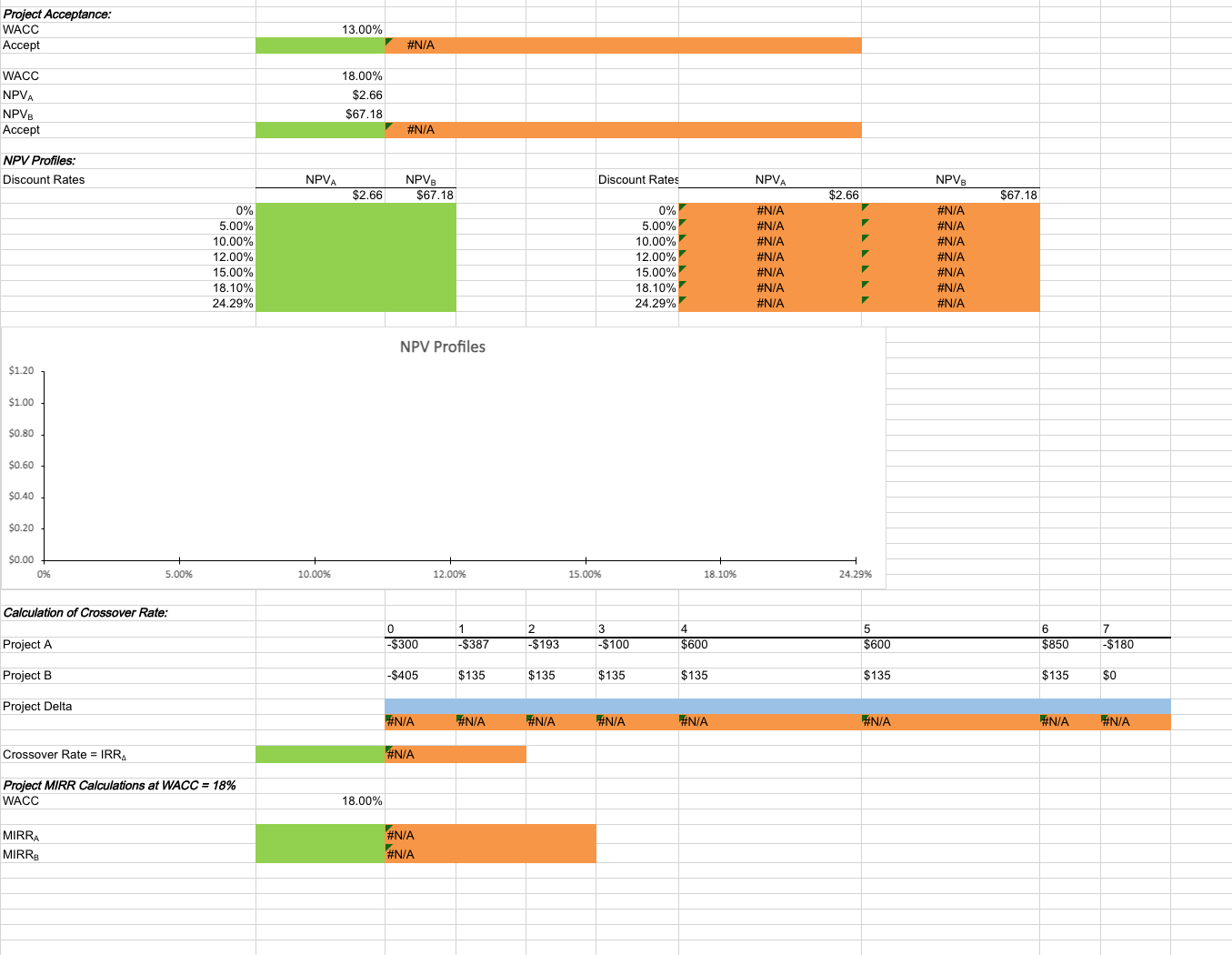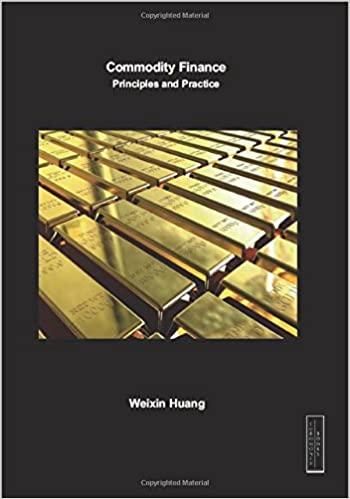Answered step by step
Verified Expert Solution
Question
1 Approved Answer
Capital budgeting criteria WACC Project A Project B Project NPV Calculations: NPVA NPVB Project IRR Calculations: IRRA IRRB Project MIRR Calculations: MIRRA Alternatively, MIRRA can


 Capital budgeting criteria WACC Project A Project B Project NPV Calculations: NPVA NPVB Project IRR Calculations: IRRA IRRB Project MIRR Calculations: MIRRA Alternatively, MIRRA can be calculated as: Project A PV of Year 1 Outflow PV of Year 2 Outflow PV of Year 3 Outflow PV of Year 7 Outflow Sum of Outflow PVs N PMT FV MIRRB Alternatively, MIRRB can be calculated as: Project B Sum of Outflow PVs N PV PMT PMT I/YR=MIRRB 13.00% \begin{tabular}{lllllllll} 0 & 1 & 2 & 3 & 4 & 5 & $600 & 6 & 7 \\ \hline$300 & $387 & $193 & $100 & $600 & & $850 & $180 & \\ $405 & $135 & $135 & $135 & $135 & $135 & $135 & $0 \end{tabular} Formulas \#N/A \#N/A \#N/A \#N/A \#N/A N/A a. What is each project's NPV? Round your answer to the nearest cent. Do not round your intermediate calculations. Project A: \$ Project B: \$ b. What is each project's IRR? Round your answer to two decimal places. Project A: % Project B: % Project A: % Project B: % d. From your answers to parts a-c, which project would be selected? If the WACC was 18%, which project would be selected? % g. What is each project's MIRR at a WACC of 18% ? Round your answer to two decimal places. Do not round your intermediate calculations. Project A: % Project B: % Capital budgeting criteria WACC Project A Project B Project NPV Calculations: NPVA NPVB Project IRR Calculations: IRRA IRRB Project MIRR Calculations: MIRRA Alternatively, MIRRA can be calculated as: Project A PV of Year 1 Outflow PV of Year 2 Outflow PV of Year 3 Outflow PV of Year 7 Outflow Sum of Outflow PVs N PMT FV MIRRB Alternatively, MIRRB can be calculated as: Project B Sum of Outflow PVs N PV PMT PMT I/YR=MIRRB 13.00% \begin{tabular}{lllllllll} 0 & 1 & 2 & 3 & 4 & 5 & $600 & 6 & 7 \\ \hline$300 & $387 & $193 & $100 & $600 & & $850 & $180 & \\ $405 & $135 & $135 & $135 & $135 & $135 & $135 & $0 \end{tabular} Formulas \#N/A \#N/A \#N/A \#N/A \#N/A N/A a. What is each project's NPV? Round your answer to the nearest cent. Do not round your intermediate calculations. Project A: \$ Project B: \$ b. What is each project's IRR? Round your answer to two decimal places. Project A: % Project B: % Project A: % Project B: % d. From your answers to parts a-c, which project would be selected? If the WACC was 18%, which project would be selected? % g. What is each project's MIRR at a WACC of 18% ? Round your answer to two decimal places. Do not round your intermediate calculations. Project A: % Project B: %
Capital budgeting criteria WACC Project A Project B Project NPV Calculations: NPVA NPVB Project IRR Calculations: IRRA IRRB Project MIRR Calculations: MIRRA Alternatively, MIRRA can be calculated as: Project A PV of Year 1 Outflow PV of Year 2 Outflow PV of Year 3 Outflow PV of Year 7 Outflow Sum of Outflow PVs N PMT FV MIRRB Alternatively, MIRRB can be calculated as: Project B Sum of Outflow PVs N PV PMT PMT I/YR=MIRRB 13.00% \begin{tabular}{lllllllll} 0 & 1 & 2 & 3 & 4 & 5 & $600 & 6 & 7 \\ \hline$300 & $387 & $193 & $100 & $600 & & $850 & $180 & \\ $405 & $135 & $135 & $135 & $135 & $135 & $135 & $0 \end{tabular} Formulas \#N/A \#N/A \#N/A \#N/A \#N/A N/A a. What is each project's NPV? Round your answer to the nearest cent. Do not round your intermediate calculations. Project A: \$ Project B: \$ b. What is each project's IRR? Round your answer to two decimal places. Project A: % Project B: % Project A: % Project B: % d. From your answers to parts a-c, which project would be selected? If the WACC was 18%, which project would be selected? % g. What is each project's MIRR at a WACC of 18% ? Round your answer to two decimal places. Do not round your intermediate calculations. Project A: % Project B: % Capital budgeting criteria WACC Project A Project B Project NPV Calculations: NPVA NPVB Project IRR Calculations: IRRA IRRB Project MIRR Calculations: MIRRA Alternatively, MIRRA can be calculated as: Project A PV of Year 1 Outflow PV of Year 2 Outflow PV of Year 3 Outflow PV of Year 7 Outflow Sum of Outflow PVs N PMT FV MIRRB Alternatively, MIRRB can be calculated as: Project B Sum of Outflow PVs N PV PMT PMT I/YR=MIRRB 13.00% \begin{tabular}{lllllllll} 0 & 1 & 2 & 3 & 4 & 5 & $600 & 6 & 7 \\ \hline$300 & $387 & $193 & $100 & $600 & & $850 & $180 & \\ $405 & $135 & $135 & $135 & $135 & $135 & $135 & $0 \end{tabular} Formulas \#N/A \#N/A \#N/A \#N/A \#N/A N/A a. What is each project's NPV? Round your answer to the nearest cent. Do not round your intermediate calculations. Project A: \$ Project B: \$ b. What is each project's IRR? Round your answer to two decimal places. Project A: % Project B: % Project A: % Project B: % d. From your answers to parts a-c, which project would be selected? If the WACC was 18%, which project would be selected? % g. What is each project's MIRR at a WACC of 18% ? Round your answer to two decimal places. Do not round your intermediate calculations. Project A: % Project B: % Step by Step Solution
There are 3 Steps involved in it
Step: 1

Get Instant Access to Expert-Tailored Solutions
See step-by-step solutions with expert insights and AI powered tools for academic success
Step: 2

Step: 3

Ace Your Homework with AI
Get the answers you need in no time with our AI-driven, step-by-step assistance
Get Started


